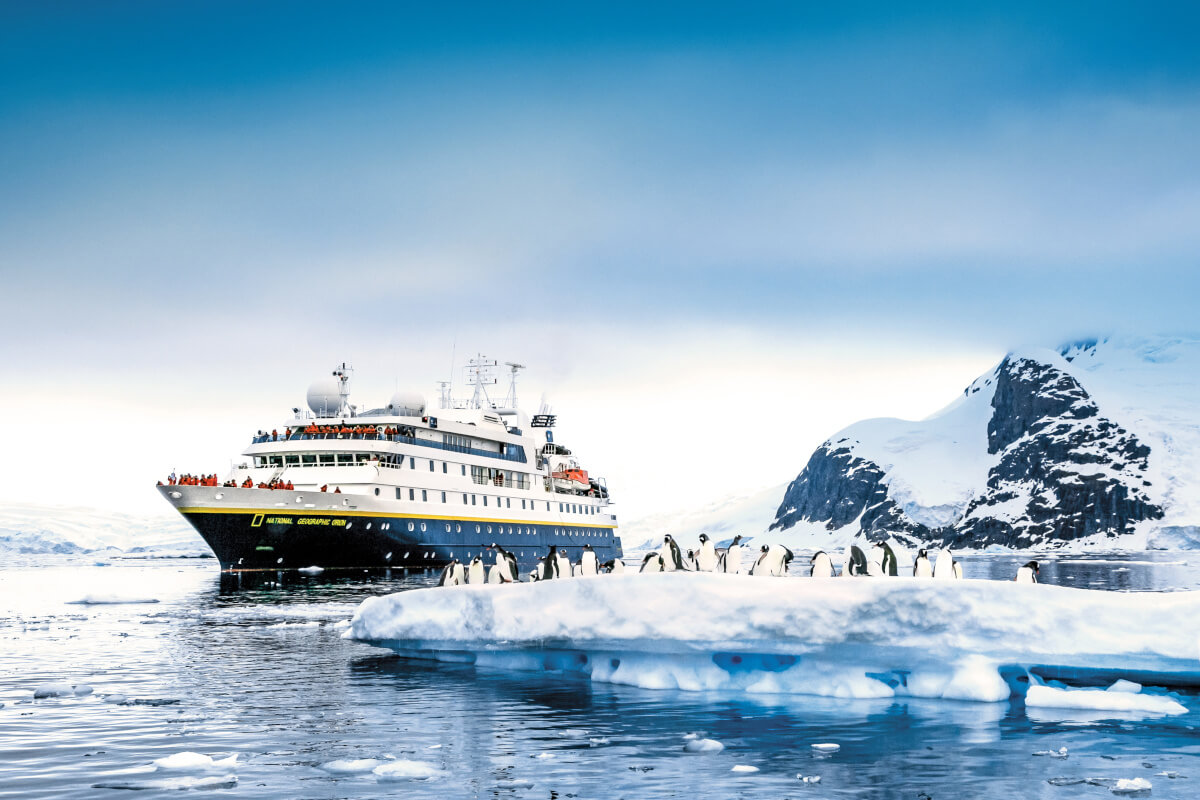There are many, many reasons to want to visit Antarctica: the dashing history of the Heroic Age of exploration; the penguins; the majestic bergs and glaciers; the breathtaking mountains surging 9,000 feet straight up from the sea; the ability to see for hundreds of miles through dust-free air; or the profound absence of anything man-made.
Antarctica is a place of extraordinary natural beauty that calls to many travelers. It is one of
the world’s last great wildernesses, providing travelers with the opportunity to experience
genuine pristine wildness. And it is inarguably threatened by climate change, providing an
urgent mission for many to view this increasingly vulnerable ecosystem.
However, the risks, inherent in any travel, of bringing guests to a remote and fickle
the environment are magnified in Antarctica because there are more ways to get into danger
and fewer rescue resources for vessels in trouble. Over the last several years, safety has
become an increasingly important component of any discussion on Antarctica since many
more travel companies are sending ships there.
A century ago, visiting Antarctica was only possible for explorers and scientists. The first
vessel specifically built for the purpose of taking ‘citizen explorers’ to Antarctica was the
ice-strengthened Lindblad Explorer launched in 1969. She paved the way for travelers to
experience the world’s last pristine continent by means of “expedition cruising”—defined
by the industry as cruising coupled with education as a major theme. By the late 1980s,
four companies were conducting ship-borne tourism to the Antarctic. By 1992 when IAATO
(Int’l Assn. of Antarctica Tour Operators, a self-regulating member organization designed
to advocate, promote, and practice safe and environmentally responsible private-sector
travel to Antarctica—now in its 28th year) was founded, approximately 6,700 tourists had
visited Antarctica. And currently, the number of global annual visitors, based on IAATO’s
2018/19 estimate, is over 56,000.
IAATO members currently subscribe to voluntary policies, including limiting the number
of guests allowable ashore at once. Ships carrying 200 or more passengers are limited
to certain sites. And ships carrying more than 500 passengers are restricted to “cruise
only” status, with no landings. Despite Antarctica’s remoteness and inherent wildness, it is
unequivocally possible to safely voyage there, and to have an extraordinary experience—
intimate, personal, exhilarating, life-changing. Lindblad Expeditions has created this guide to help you make informed decisions that will lead to the adventure of a lifetime.
What kind of ship is best?
The style of vessel you choose for your Antarctic adventure will define your expedition experience. The kinds of vessels currently voyaging to Antarctica are large and smaller cruise ships, icebreakers, polar adventure ships, and fully-equipped expedition ships.
For maximum safety, and to have a more in-depth experience, choose a polar-class
vessel with a high ice rating in combination with a veteran ice team noted for
superior navigational skills—both essential for safe and rewarding travel. National
Geographic Explorer and National Geographic Orion have a very high, classic ice strength rating. The twin ships National Geographic Endurance and National Geographic Resolution will be built within the icebreaker category, which allows the ships to penetrate deeper in both the Arctic and Antarctic waters.
The newest vessels in Lindblad’s fleet, National Geographic Endurance and National Geographic Resolution, will be built at the same time as a number of new polar-going cruise ships, intended to carry 200-500 or more guests, yet their guest capacity
was deliberately limited to 126. National Geographic Orion carries a 102-guest community. And National Geographic Explorer accommodates 148 guests. The intimate scale of these ships, their low guest count, plus veteran staff and crew, contributes to Lindblad-National Geographic’s unique ability to maximize daily opportunities to get off ship and out
exploring. Swift and smooth logistics are key so guests are not forced to wait their turn amid a large cohort. The combination of the polar-adapted vessels and the proprietary ‘mud maps’ Lindblad Captains use (for decades, Lindblad Captains have kept detailed soundings, which are routinely filed with the British Hydrographic Agency to aid other mariners. This level of knowledge enables them to confidently and safely take guests to off-the-beaten-path landings for exclusive encounters)—mean the vessels can anchor in extraordinary locations, closer to shore, to quickly deploy Zodiacs or kayaks from the company’s exclusive floating platform, virtually anywhere in the ice, and provide more daily activities to more guests simultaneously.
Based on 50+ years of experience continuously running Antarctic expeditions, Lindblad ships are outfitted with the latest in seafaring technology. And each is equipped with an array of tools for exploration—Zodiacs, kayaks, ROVs, snowshoes, cross-country skis—to enable guests to enjoy active, up-close, personal explorations, and through the efforts of a dedicated onboard undersea specialist, even observe the polar marine world.
Given their high ice ratings, these ships are able to easily and safely penetrate the softer, first-year ice common in Antarctica in the early season, allowing their Captains to accomplish the magic of “parking” the ship in the ice, so guests can disembark onto a frozen sea—to snowshoe, cross-country ski, or simply walk freely about. Tough enough to provide the thrill of crushing through ice, the ships are also nimble enough to navigate safely through the growlers and bergy bits floating in Antarctic waters.
What safety features are vital?
In addition to the inherent ice-worthiness and logistical operations of the ship, there are three important components to safety in Antarctica: Captain, staff and crew experience; on-board technology; and lifesaving protocol and equipment. A recent review of the available literature quoted some operators enthusiastically entering Antarctic tourism touting an “on-board physician” as a primary safety feature. While having a doctor aboard is undoubtedly important, there is far more to ensuring guest safety in Antarctica. Here are some of the baseline criteria to use in evaluating your travel provider.
Captain and Crew Experience
Captains who have attained the necessary experience navigating polar waters are called Icemasters. An Icemaster is not only familiar with the unique wind, weather and current dynamics in polar waters, he or she is also intimately familiar with all the forms of ice and the unique
challenges each form presents.
The Captains of the Lindblad-National Geographic fleet have spent decades in the ice. Collectively, they have navigated over 500 Antarctic expeditions, ensuring that they have the crucial knowledge the company demands. And they are extraordinary mariners. For example, before
Leif Skog, Lindblad V.P. Nautical and Master of the National Geographic Explorer, became a Captain in 1984, he worked as an officer on a variety of vessels including general cargo ships, LPG-gas tankers, a multi-purposed helium deep-diving support vessel and passenger ships carrying from 800 to 1,200 passengers. And, having earned his stripes as a mariner, he then devoted his next 35 years to Captaining in the much more challenging polar regions.
| Polar class ships | National Geographic Explorer | National Geographic Orion | National Geographic Endurance | National Geographic Resolution |
|---|---|---|---|---|
Forward Scanning SonarTo scan ahead to check for uncharted |
Check | Check | Check | Check |
Double Weather ForecastingTwo independent weather forecasting |
Check | Check | Check | Check |
Ice RadarProvides an adjustable, high def image using data, allowing Captains to choose the safest route through ice |
Check | Check | Check | Check |
Ice SearchlightsTwo ice searchlights aid the naked eye in picking up hazardous ice, both in daylight and total darkness |
Check | Check | Check | Check |
GMDSS (Global Maritime & Distress Safety System)A comprehensive communication system, with multi Iridium satellite phones to completely cover polar waters and to act as a reliable backup system in any emergency |
Check | Check | Check | Check |
IAATO Emergency Response SystemDeveloped by Lindblad’s Captain Skog to ensure that all IAATO ships keep in daily touch to respond to any incident |
Check | Check | Check | Check |
Drone for Ice NavigationFacilitates ice navigation to find leads through the ice to open water near the ship |
Check | Check | Check | Check |
How Active Will Your Antarctica Experience Be?
Antarctica is a place of extraordinary natural beauty. Someone traveling there on a 2,500-guest ship can enjoy a glimpse of the same scenery as guests aboard nimble expedition ships, but most else would be lost. Because Antarctica is not mere scenery, it is a place to be experienced, an ecosystem that delights upon closer inspection. It seems obvious that the experiences of a guest on an agile, 126-guest or 148-guest ship, with the outdoors instantly accessible, and a guest on a huge cruise ship requiring elevators to reach viewing decks would be too different to compare. However, there are equally significant differences between traveling with a dedicated expedition company and other small ship operators. Investigate how engaged you will be able to be, what you’ll be able to do, and how often.
One could have a perfectly wonderful time in Antarctica seated in a deck chair with a pair of good binoculars. But genuine encounters with beauty, wildness, and the seldom-seen are the difference between wonderful and extraordinary. The Lindblad-National Geographic fleet ships travel with meaningful tools for that reason: to enable extraordinary upclose and personal experiences. Ask yourself if you’re willing to settle for seeing Antarctica from a window, or even from an outside deck, when it is possible, by choosing your operator wisely, to get out and explore. To inhabit the magnificent vastness. Hear the silence. Have leisurely encounters with penguins—without being forced to leave because others are waiting their turn. Walk, hike, climb. Try a polar plunge if you’re inclined (and many are). Learn about the geology, the climate forces. And see beneath the sea.
Equipment
The following is a list of the equipment capable of transforming your experience of Antarctica to a personal encounter with the wildlife, geology, and fantastic varieties of ice in this astonishing ecosystem.
Zodiacs and Zodiac Deployment Systems
Zodiacs are key to your ability to get out and about on explorations, so the quality of your experience will suffer without the ability to make landfall and explore that Zodiacs provide. However, having Zodiacs is not enough—deployment is an important factor too—since waiting in line in the tender area is not adventure-enhancing. The Lindblad-National Geographic ships
each carry a fleet of 11-13 Zodiacs, depending on guest count. But more importantly, the ships are designed for swift deployment. In fact, Zodiac deployment can begin even before the ship drops anchor. As a result, there is virtually no wait time in the tender area, and more time ashore engaged in activities. Efficiently designed loading bays on each vessel make embarking
and disembarking a Zodiac safe and simple for people of all fitness levels.
Kayaks
Lindblad Expeditions pioneered sea kayaking from expedition ships in polar waters, to provide guests with unprecedented opportunities for profoundly personal and exhilarating explorations in “penguin country.” Considerable time and safety testing was involved in vetting the idea of polar kayaking, before the company’s veteran expedition leaders and Captains gave the idea a
“green light.” Now each ship is equipped with a fleet of 24 to 36 stable double kayaks, not a token number, enough so everyone interested can paddle. In addition to being innovative about “personal” polar exploration, Lindblad has invented ingenious deployment protocol, designed and manufactured by the company’s engineering team. It’s a proprietary staging platform that enables the expedition team to deploy guests in kayaks in ideal locations—again, without even waiting for the ship to drop anchor. While other travel companies have copied the kayaking idea, not all do it, so if a genuinely exploratory experience matters to you, check for this feature—and how swiftly they deploy to get you out exploring, without reliance on beaches, docks, or other infrastructure.
Cross-Country Skis & Snowshoes
November is known as the early season. It often provides optimal conditions for parking the ship in the fast ice (see photo on page 6). If ice conditions permit, we take the opportunity to descend on to the fast ice with cross-country skis or snowshoes, exploring this unique aspect of Antarctica’s thrilling vastness.
Undersea Exploration
Far from cold, gray and lifeless, the polar sea is vibrant, colorful and remarkably full of life. Inspired by Jacques Cousteau, Lindblad-National Geographic is the only travel company operating in Antarctica with an extensive undersea program. Key to the program is employing an undersea specialist—he or she dons layers of dive gear, including an insulating dry-suit, plus an array of video tech in order to remain below long enough to capture HD video of the vivid
life within these frigid waters.
As a result, Lindblad-National Geographic travelers can explore the polar ocean, sitting in the warmth of the ships’ lounges. Seeing fish with anti-freeze in their blood, or swimming, plant-like crinoids—can fundamentally change the way travelers view the ocean. Some of the animals the undersea specialists have recorded on expeditions, like a large-scale worm discovered in the Weddell Sea, are so rare or unusual that even Antarctic biologists can’t identify them.
Lindblad-National Geographic ships also voyage with ROVs able to operate up to 1,000 feet below the surface, far below what any human diver can reach. Often when Lindblad specialists deploy the ROV, is filming areas no one has ever seen before.
Lindblad ships also act as platforms for scientists to conduct research. From taking DNA samples from Antarctic killer whales to enabling James Balog to set his Extreme Ice Survey cameras on Antarctic and South Georgia’s glaciers, Lindblad-National Geographic is reconceiving the vital role expedition ships, and the intelligent, curious travelers aboard can play in advancing polar science.
Onboard Experts
Most travel companies operating in Antarctica claim to have knowledgeable experts onboard. It can be hard, therefore, to determine how to assure yourself of the most authentic, engaging, and informative experience. One metric may be to consider how the staff backgrounds match up with your personal interests. A generous ratio of staff to guests is another empirical gauge to use in judging an operator. A small number of guides can mean both fixed assignment to a group, and/or larger groups.
Over the 50+ years, Lindblad Expeditions’ history, their veteran staff, and the quality
the companionship they provide has established their reputation. From expedition leaders to
naturalists, their staff is expert or gaining field experience under veteran mentorship. Some
have been traveling to Antarctica for over 30 years, others for 20+ years, and most hold
advanced degrees. On every voyage, the composition of the staff is chosen to ensure
a diverse range of expertise from geology to history to marine mammals; and all the naturalists
are able to establish context and answer questions in their specialty. Equally important,
Lindblad invests significantly in a large number of naturalists, to keep an excellent guest to
expedition staff ratio of 10:1, or better. Guests are not herded around in large groups, but
can gravitate naturally to the staffers they’re most interested in or opt to head out with
different individuals on each day’s activities.
And since 2004, the Lindblad-National Geographic alliance offers valuable resources, as well—top-tier National Geographic photographers accompany every voyage. Whether you are a camera-phone user, or an advanced photographer, you’ll have unprecedented opportunities to get tips
and on-site guidance from top pros—in the field where it counts. And the presence
of National Geographic researchers and explorers aboard the fleet, plus the Global Perspectives Guest Speaker program on National Geographic Explorer, provide guests with insights from varied, interesting, fellow guest explorers. Whether it’s a National Geographic photo editor sharing how she puts together a magazine story; three former astronauts satisfying their yearning to explore new corners of the planet; or research scientists able to conduct field tests simply because Lindblad-National Geographic provided a platform, travelers aboard the
fleet get insider stories and views.
Passion and enthusiasm are endemic, and guests often comment how the staff seems just as excited as they are over a pod of killer whales hunting for seals on ice floes, or the antics of a penguin pecking at a boot. They are active participants in the traveler’s experience, not just passive lecturers, and are always willing to engage, to continue the conversation over a drink in the lounge, over dinner, or on the Bridge.
Summary
A voyage to Antarctica is one of the most exhilarating adventures the planet offers, and one of the most life-enhancing travel decisions any traveler can make. This guide was created to nurture your dream of discovering Antarctica, by helping you understand what’s involved so you can select wisely, and safely enjoy the adventure of a lifetime. We hope you found the information provided valuable, and that it serves you well in making your travel decision.
In any comparison between the various travel operators offering voyages to Antarctica, Lindblad Expeditions-National Geographic will inevitably emerge the clear best choice, albeit not the least expensive. Whether you select based on fleet qualifications, the tenure and safety record, or the caliber and commitment of the expedition teams, you can confidently expect Lindblad Expeditions-National Geographic to provide you with an experience that will exceed your every expectation. Enjoy the fruits of your thoughtful research—a spectacular Antarctica experience.



